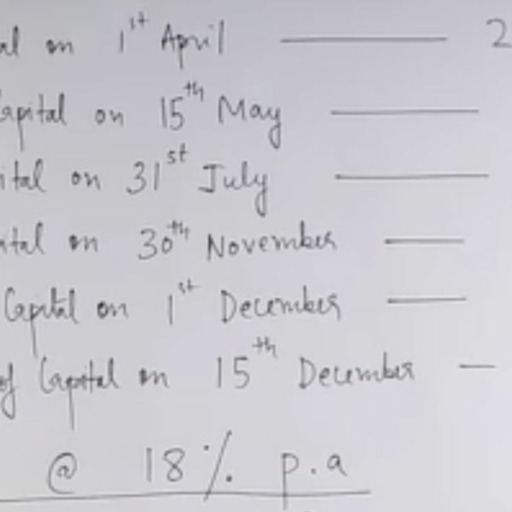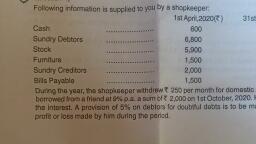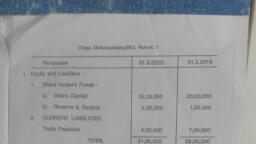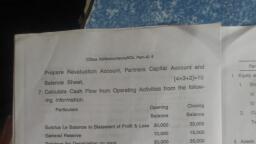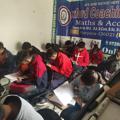Question 1 :
Find the vector $w$ with the initial point $(a,b,c)$ and final point $(a+1,b+2,c+3)$.
Question 3 :
Given that x,y,z are the co-ordinates of a vector in terms of the base $\displaystyle \overrightarrow{OL},\overrightarrow{OM},\overrightarrow{ON}$ find its co-ordinates in terms of the base  $\displaystyle\overrightarrow{OL}, \overrightarrow{ON}. \overrightarrow{OM},$
Question 4 :
Given $\vec{p}=3\hat{i}+2\hat{j}+4\hat{k}, \vec{a}=\hat{i}+\hat{j}, \vec{b}=\hat{j}+\hat{k}, \vec{c}=\hat{i}+\hat{k}$ and $\vec{P}=x\vec{a}+y\vec{b}+z\vec{c}$, then $x, y, z$ are respectively.
Question 7 :
The vectors $\bar{a}, \bar{b}, \bar{c}$ are of the same length and taken pair wise, they form equal angles. If $\bar{a}=\bar{i}+\bar{j}$ and $\bar{b}=\bar{j}+\bar{k}$ then the components of $\bar{c}$ are?
Question 8 :
Let $P=(1, 0, -1)$ $Q=(-1, 2, 0)$ $R=(2, 0, -3)$ and $S=(3, -2, -1)$, then the length of the components of RS on PQ is?
Question 9 :
If $\vec { b } =3\hat { i } +4\hat { j } $ and $\vec{ a } =\hat { i } -\hat { j } $ the vector having the same magnitude as that of $\vec{b}$ and parallel to $\vec{a}$ is
Question 10 :
What should be added in vector $3i+4j-2k$ to get its resultant a unit vector $i.$ 
Question 11 :
The position vectors of two points A and B are $i + j - k$ and $2i - j + k$ respectively. Then $\displaystyle \left| AB \right| =$ 
Question 12 :
Find non-zero scalars $\displaystyle \alpha ,\beta $ such that for all vectors a and b.<br>$\displaystyle \alpha \left( 2a-b \right) -\beta \left( a+2b \right) =4a-b$
Question 13 :
If the position vectors ofthe vertices A, B, C of a triangle ABC are $7 \widehat j + 10 \widehat k, - \widehat i + 6 \widehat j + 6 \widehat k$ and $- 4 \widehat i + 9 \widehat j + 6 \widehat k$ respectively, the triangle is
Question 15 :
If $G$ is the centroid of the triangle $ABC$ then $\vec{GA}+\vec{GB}+\vec{GC}$ is equal to <br/>
Question 16 :
$P, Q, R, S$ have position vectors $\overline{p},\overline{q},\overline{r},\overline{s}$ respectively such that $\overline{p}-\overline{q}=2(\overline{s}-\overline{r})$, then which of the following is correct<br/>
Question 17 :
Let $\vec{A}=\hat{i}+2\hat{j}{+}3\hat{k},\ \vec{B}=4\hat{i}+2\hat{j},\ \vec{C}=2\hat{i}+2\hat{j}{+}2\hat{k}$. Then the ratio in which $C$ divides $AB$ is<br/>
Question 18 :
If $\overline{a}$ and $\overline{b}$ are position vectors of $A$ and $B$ respectively, then the position vector of a point $C$ in $AB$ produced such that $\overline{AC}=3\overline{AB}$ is<br/>
Question 19 :
The position vectors of the points $A$ and $B$ are respectively $3\hat { i } -5\hat { j } +2\hat { k } $ and $\hat { i } +\hat { j } -\hat { k } $. What is the length of $AB$?
Question 20 :
Position vectors of mid point of the vector joining the points $P(2, 3, 4)$ and $Q (4, 1, -2)$ is<br/>
Question 21 :
If A and B are the points $(2,1,-2),(3,-4,5)$, then the angle that $OA$ makes with $OB$ is:
Question 23 :
Let $\mathrm{A}\mathrm{B}\mathrm{C}\mathrm{D}$ be a parallelogram and let $\mathrm{L}$ and $\mathrm{M}$ be the midpoints of the sides ${ BC } $ and $ { CD }$  respectively. Then  $\vec { AL } +\vec { AM } =$<br/>
Question 24 :
If $A(\overline{a})$ , $B(\overline{b})$ and $C(\overline{c})$ be the vertices of a triangle $ABC$ whose circumcentre is the origin then orthocentre is given by<br/>
Question 25 :
Let $G$ and $G^{1}$ be the centroids of the triangles $ABC$ and $A^{1}B^{1}C^{1}$ respectively, then $AA^{1}+BB^{1}+CC^{1}$ is equal to<br/>
Question 27 :
The vector<br/>$\vec a + \vec b,\vec a - k\vec b$ where $k$ scalar are collinear, for
Question 28 :
Given that u is a vector of length $2$, v is a vector of length $3$ and the angle between them when placed tail to tail is $\displaystyle 45^{\circ} $, which option is closest to the exact value of $\vec u\cdot\vec v$ ?
Question 29 :
If $\vec {a} . \hat {i} = \vec {a} . (\hat {i} + \hat {j}) = \vec {a} (\hat {i} + \hat {j} + \hat {k})$, thus $\vec {a}=$
Question 30 :
The work done by the force $\vec { F } = 2 \hat { i } - \hat { j } - \hat { \mathbf { k } }$ in moung an object along the vector $3 \hat { i } + 2 j - 5 \hat { k }$ is
Question 31 :
If $\vec a$ is parallel to $\vec b \times \vec c$, then $(\vec a \times \vec b) \cdot (\vec a \times \vec c)$ is equal to
Question 32 :
If $\mid \vec a \mid = 2$ and $\mid \vec b \mid = 3$ and $\vec a \cdot \vec d = 0$, then $(\vec a \times (\vec a \times (\vec a \times (\vec a \times \vec b ))))$ is equal to
Question 33 :
If $\vec a=\hat i+2\hat j$ and $\vec b = 3\hat j$, then $\vec a\cdot\vec b=$<br/>
Question 34 :
The set of values of $c$ for which the angle between the vectors $cx\hat{i}-6\hat{j}+3\hat{k}$ and $x\hat{i}-2\hat{j}+2cx\hat{k}$ is acute for every $x\in R$ is
Question 36 :
Let $\vec{a}=\hat{i}+\hat{j}+\hat{k}$ and $\vec{b}$ is a vector such that $\vec{a}.\vec{b}=0$ and $\vec{a}\times \vec{b}=0$. Then which of following is correct?
Question 37 :
The projection of the vector $\vec a = 4\hat i - 3\hat j + 2\hat k$ on the vector making equal angles (acute) with coordinate axes having magnitude $\sqrt{3}$ is
Question 38 :
The values of a, for which the points A,B,C with position vectors $\displaystyle 2\hat{i}-\hat{j}+\hat{k},\hat{i}-3\hat{j}-5\hat{k}$ and $\displaystyle a\hat{i}-3\hat{j}+\hat{k}$ respectively are the vertices of a right angled triangle with C=$\displaystyle \frac{\pi}{2} $ are
Question 39 :
If $\overline { a } - \overline { b }$ is perpendicular to $\overline { a } , | b | = \sqrt { 2 } | \overline { a } | ,$ then
Question 40 :
If for two non-zero vectors a,b : $\left| {a + b} \right| = \left| {a - b} \right|$ then angle between them is 
Question 41 :
If $\bar A\bar B = 2\bar i - 3\bar j + \bar k,\bar C\bar B = \bar i + \bar j + \bar k,\bar C\bar D = 4\bar i - 7\bar j$ then $\bar A  \bar D$ =<br/>
Question 42 :
If $\vec d = \vec a \times \vec b + \vec b \times \vec c + \vec c \times \vec a$ is a non-zero vector and $\mid (\vec d \cdot \vec c) (\vec a \times \vec b) + (\vec d \cdot \vec a) (\vec b \times \vec c) + (\vec d \cdot \vec b) (\vec c \times \vec a) \mid = 0$, then
Question 43 :
$\hat { i }. \left( \hat { j } \times \hat { k } \right) +\hat { j } .\left( \hat { i } \times \hat { k } \right) +\hat { k } .\left( \hat { i }\times \hat { j } \right) $ is equal to
Question 45 :
$(\overline {a} - \overline {d}) \cdot (\overline {b} - \overline {c}) + (\overline {b} - \overline {d})\cdot (\overline {c} - \overline {a}) + (\overline {c} - \overline {d}\cdot (\overline {a} - \overline {b}) =$
Question 46 :
If $\left|\overrightarrow{a}\right|=\left|\overrightarrow{b}\right|=\left|\overrightarrow{c}\right|=1$ and $\overrightarrow{a}.\overrightarrow{b}=\overrightarrow{b}.\overrightarrow{c}=\overrightarrow{c}.\overrightarrow{a}=\cos{\theta}$, then the maximum value of $\theta$ is
Question 47 :
The vector $\hat i+x\hat j+3\hat k$ is rotated through an angle $\theta$ and doubled in magnitude, then it become $4\hat i+(4x-2) \hat j+2\hat k$. The sum of all possible values of $x$ is.
Question 48 :
$\vec { a } , \vec { b } , \vec { c }$ are three mutually-perpendicular unit vectors then $| \vec { a } + \overline { b } + \vec { c } |$ is equal to ?
Question 50 :
$\vec{a}, \vec{b} $ and $\vec{c}$ are three vectors with magnitude $|\vec{a}|= 4, |\vec{b}| = 4, |\vec{c}| =2 $ and such that $\vec{a}$ is perpendicular to $(\vec{b}+\vec{c}), \vec{b}$ is perpendicular to $(\vec{c}+\vec{a})$ and $\vec{c}$ is perpendicular to $(\vec{a}+\vec{b})$. It follows that $|\vec{a}+\vec{b}+\vec{c}|$ is equal to:

